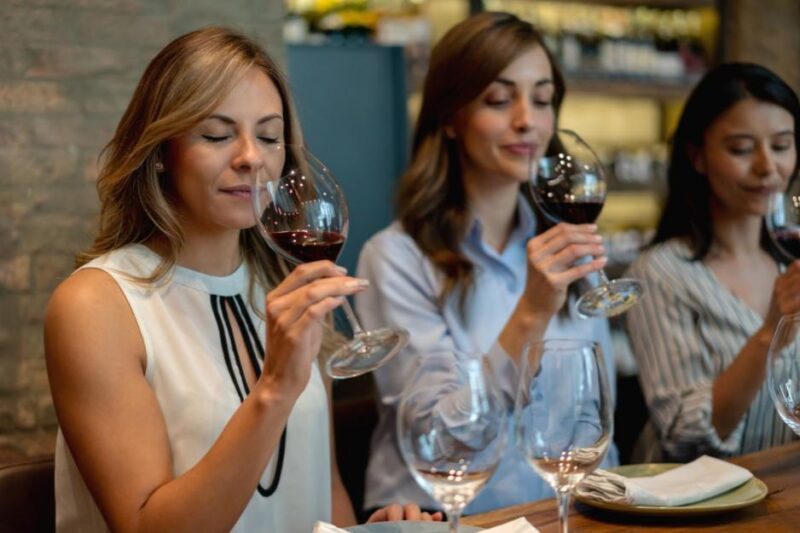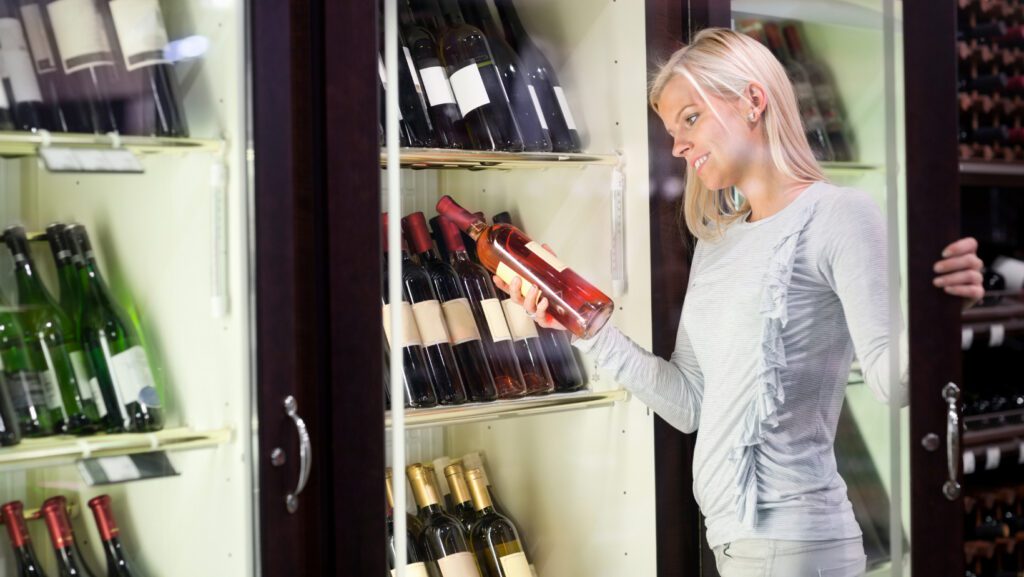Whether you’re a wine professional or an enthusiast, wine tasting events are meant to be enjoyed, and every sip savored. This process is even more interesting when done with friends, family, or a partner.
However, wine tasting events are only as good as your wine tasting skills. You don’t want to be clueless when other wine professionals are analyzing and discussing wines. To blend in better and create a memorable experience, you need to know the steps to take and how to engage every sense to identify and enjoy aromas and flavors while having a good laugh. To achieve this, you need to know the basics of wine tasting.
Wine tasting is an intricate and interesting process. It refers to the act and practice of assessing wine, usually in a formal setting where one assesses several wines. A certified wine professional called a sommelier, must have a great deal of insight into wine through this assessment. However, wine tasting isn’t just for sommeliers, curious wine lovers and wine enthusiasts can also master this art.
In this piece, we will teach you the techniques needed to appreciate and enjoy every sip of wine while seamlessly identifying wine tasting notes, tastes, and aromas.
The Five S’s of Wine Tasting
The process of wine tasting is encapsulated in the five S’s: See, Swirl, Sniff, Sip, and Savor. This is a systemic approach to wine tasting that ensures a holistic and thorough wine evaluation. Let’s expound more on the five S’s of wine tasting:
See
The first step is to assess the color and clarity of the wine, noting the intensity of the color. For instance, you want to see whether the color is a vibrant red, pale straw or golden yellow. The color of the wine will often give you an idea of its age, the type of aromas to expect, tannin levels, acidity, and sweetness.
Red wines with a purple tint, like the Young Malbec, are often young wines that are juicy, fruity, light, or medium-bodied. Conversely, if your red wine has a brown or tawny tinge, like in Tawny Port, it may be aged with more intense flavors. The hue or hint usually depends on the type of wine – red, white, or rose wine. White wines may range from pale yellow or straw to deep yellow color, while red wines range from light purple hues to tawny or deep brown color.
In summary, lighter-colored wines are often younger and light-bodied, while darker wines are full-bodied, more acidic, and have complex flavors. Furthermore, take note of the wine’s viscosity and transparency, as these offer more insights into the wine’s age and potential characteristics.
Swirl
Next, swirl the wine in the glass to introduce oxygen, which opens up and releases the wine’s aromas. As you swirl, pay attention to the ‘tears’ or ‘legs’ that form inside the glass; they provide clues about the wine’s alcohol content.
When swirling wine or moving it inside your wine glass, you may notice drops streaking down the glass (think of raindrops sliding down your glass window, yes, that!). Those drops are called the wine legs or “tears of wine.” When you move the wine around the glass or tilt it, the alcohol slightly evaporates while its water content forms tear-shaped droplets. The faster or more easily these droplets form, the higher the alcohol and sugar content.
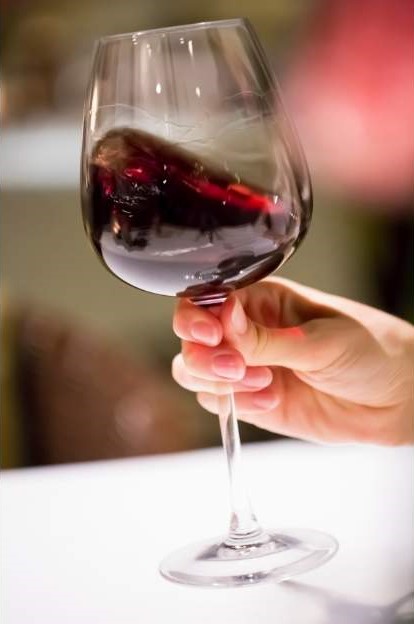
Sniff
The next step is to bring the glass to your nose and inhale deeply; this helps you identify the aromas. Know the difference between primary, secondary, and tertiary aromas, and note any fruit, floral, herbal, or spicy aromas.
Primary aromas come directly from the grapes and other main ingredients used. These may be fruits, spices, or herbs, and if you’re familiar with these scents, they may be easy to pick. If you’re sensitive enough, you may be able to pick fruity notes like blackcurrant, apples, blackberry, or pineapple. You can also pick herbal aromas like eucalyptus, mint, or lavender and spicy aromas like cloves and nutmeg. These aromas are usually easier to smell in youthful wine.
Conversely, the secondary aroma is produced based on the type of wine processing and the conditions surrounding this process. This includes the type of fermentation process and temperature used. For instance, wines that undergo malolactic fermentation (where malic acid is converted to lactic acid), like Chardonnay, may produce creamy or nutty aromas. Meanwhile, oaky fermentation produces leathery, spicy, or toasty notes.
Lastly, tertiary aromas are quite different and are a result of aging and the type of container the wine is stored in. For example, wines stored in barrels for prolonged periods may develop coffee or chocolate aromas. On the other hand, wines stored in bottles for months or years may develop earthy or vegetable aromas.
There are over a thousand aroma varieties, which may be overwhelming, but with some patience and repetition, it gets easier to pick up these scents.
Sip
Sipping the wine helps you assess the wine’s taste and texture; therefore, pay attention to the initial impression, mid-palate flavors, and finish. Also, note the wine’s sweetness, tannins, and acidity, as well as how these interact with the palate.
Wines can be sweet, sour, bitter, or salty and are generally acidic because they are all made from grapes; however, the level of acidity differs. You can tell how acidic a wine is based on its crispness and sourness; the more sour the wine is, the more acidic it is. On the other hand, tannins have to do with texture. You know that distinct rough and mouth-dry feeling you get after drinking black coffee? That’s what tannin wines feel like on your palate. They reveal the age of the wine and the amount of grape skin used to make it. Youthful wines are often high in tannins, but this will soften as the wine ages.
You can also decipher whether a wine is light, medium, or full-bodied, depending on how it feels in your mouth. Light-bodied wines like Pinot Noir often feel like flavored water, e.g. lemon-infused water, while full-bodied wines like the Malbec are usually rich, viscous, thick, and may be likened to freshly squeezed juice or full milk – you can almost cut through them.
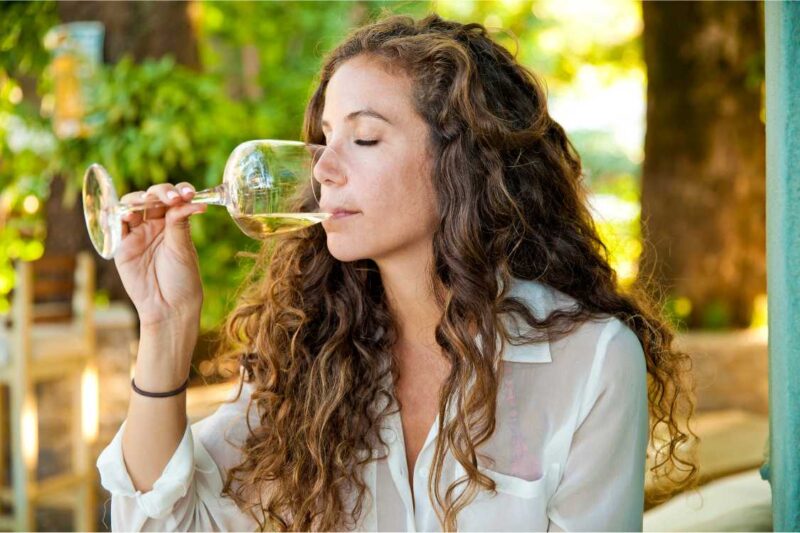
The finishing of a wine simply means how long the aftertaste lasts. For context, wines with short finishes last seconds, while those with long finishes linger for minutes, leaving a mix of pleasant flavors.
Savor
The last S is savoring the wine’s finish and aftertaste; note the lingering flavors and their evolution on the palate. Also, consider how long the finish lasts; is it short and crisp or long and lingering?
Understanding Wine Characteristics
There are five basic characteristics of wine: sweetness, acidity, tannin, alcohol, and body. Each of these characteristics is used to describe a wine, whether it is earthy, zesty, or oaky.
- Sweetness: Wine sweetness is one of the most distinguishable characteristics of wine and it usually comes from the residual sugar. Also, it is the main factor that contributes to the calorie count of a wine glass.
- Acidity: Wine acidity plays a significant role in the wine’s tartness, where grape acid levels reduce as they ripen. Most of the acidity, including malic, tartaric, and citric, in wine comes from grapes, sitting between 2.5 and 4.5 pH levels.
- Tannin: Tannins, also known as polyphenols, are naturally existing compounds inside a grape skin, seed, and stem. They are released from each grape as they soak in their juices immediately after the pressing of the grape.
- Alcohol: Alcohol is called ethanol, and it is one of the key characteristics of wine. The wine is a result of the fermentation that grapes undergo during wine production. Apart from the texture and viscosity, alcohol also plays a role in the aroma of the wine.
- Body: The last is the body, which is made up of sweetness, acidity, tannin, and alcohol. When referring to a wine body, we use the terms light, full, or medium-bodied. The differences between light-bodied and full-bodied are acidity, alcohol, tannin, and sweetness. Full-bodied wines are sweeter and usually have higher alcohol content, tannins, and better mouthfeel compared to light-bodied wines. Conversely, light-bodied wines tend to be more acidic.
Wine Tasting Techniques
Wine tasting is not difficult if you can understand the techniques. Here is how to taste wine like a pro with a good mastery of wine-tasting techniques.
- Note the appearance: Pour some wine into the glass – around a finger’s breadth. Then, angle and hold the glass to bring it above something white and examine its appearance.
- Smell: Swirl the wine to mix it with oxygen, bring your nose closer, and breathe in gently.
- Taste: Take a small sip of the wine, hold it in your mouth, swirl it around, and breathe in a little.
- Make Your Assessment: Determine if the taste is balanced, how strong the flavors were, how long they lasted, and if there were many different flavors.
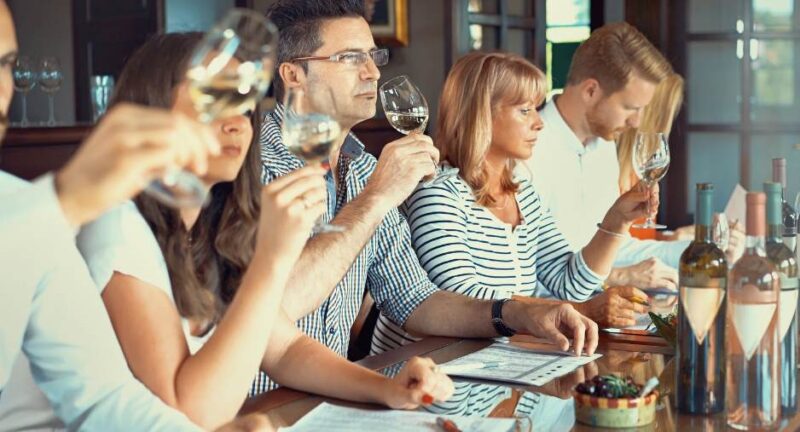
Wine Tasting Notes
Taking notes during wine tasting is a valuable practice for every wine enthusiast, not just connoisseurs. So, you need a wine journal for this exploration of the journey. Here is a list of what to include in your wine-tasting journal:
The basic identifying information of the wine – including its producer, the wine’s full name, the vintage, price, alcohol percentage, and grape varieties.
- Appearance – note the color as well as other unusual elements such as paleness or darkness.
- Aromas and flavors and how subtle or powerful they are
- Structure, including the acidity, tannins, body, alcohol, and texture.
- Finish – how long did the taste last on your palate?
- Rating – sum up your impressions with a rating, using a number of stars or marks out of ten.
Wine Tasting Etiquette
Maintaining good wine tasting etiquette keeps you from making any wine-tasting faux pas. Etiquette to follow when performing the art of wine tasting includes:
- Do not wear cologne or perfume to keep your sense of taste and smell clear.
- Practice moderation with multiple wines; you don’t want to have too much to drink.
- Always request the policies and etiquette of someone else’s wine-tasting events. If you’re the host, ensure your guests know your etiquette.
- Avoid “asking for the good stuff,” but you can ask for reserve wines beyond your host’s usual offerings. If you do, be sure to make a purchase, as that is the polite thing to do.
- Avoid asking for another wine sampling unless you intend to make a purchase.
- Make a purchase, but do not haggle over the price; they deserve whatever they’re asking for.
Wine Tasting Tips for Beginners
If you’re new to wine tasting, here are wine tasting tips for beginners to make the experience a fruitful one for you:
- Take notes as you taste; don’t jump to conclusions if you’re tasting blind.
- Store your wine tasting notes using a file or app.
- Hone your nose by tasting blind; have a friend give you wines with their labels covered, and then try to identify them.
- Build your flavor vocabulary by consciously smelling them so you can identify them later.
- If you’re unable to decipher the wine, leave it and return to it at a later time. The wine might need time to open up, or your nose may just be tired.
- Use tulip-shaped ISO tasting glasses for wine tasting; ensure they are clean and free of cleaning product residue.
Conclusion
Like many other activities, wine tasting is an art and takes time and practice to perfect. So take that glass of wine, observe its color, gently sniff it, take a sip, and take a second to savor it. What did you pick? Now, try this a couple more times and with different wines, then discuss it with friends, family, or a professional wine taster – in no time, you’ll be assessing wines like a pro.

